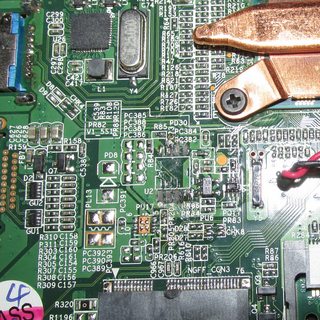Author: Larry.Moberg@puri.sm
This post gives some details on the Librem 15 rev2 prototype. One challenge with developing BIOS is finding parts that can be reused; coreboot makes heavy reuse of certain pieces of code.
Very Similar
Starting with the chips on the back of the mainboard, the 15 prototype uses the same ene KB3930QF-A1 as the Librem 13, and it is configured to read from an external Macronix MX25L512 SPI flash for firmware. The 15 has this SPI chip on the front side of the board between the DIMMs and the USB3 ports.
The 15 prototype uses a Realtek ALC269 codec via the AC’97. The Librem 13 should have a very similar codec.
On the front (the side visible just by removing the back laptop case), the 15 prototype uses an MX25L6406E SPI flash for the BIOS. The Librem 13 prototype uses a GD25Q64B, but other than the Intel Firmware Descriptor fields for JEDEC ID etc, these chips are interchangeable.
Both CPUs are Broadwell-U. They use the same FSP. They both have the LPC bus exposed on pads.
These similarities help us by reducing the amount of variation between the board subdirs in coreboot and can use the same development rig.
Acceptance Test Matrix
We’ve put together the following tests to validate coreboot builds:
- Cold boot: memory controller works.
- Cold boot: all installed DRAM is online.
- Cold boot: graphics controller works.
- Cold boot: SATA controller succeeds.
- Cold boot: EC controller responds ok to init code.
- Cold boot: LCD backlight turns on.
- Cold boot: linux boots ok in text mode.
- Cold boot: linux boots ok in framebuffer (boot splash) mode.
- Cold boot: X initializes the LCD at full native resolution.
- Cold boot: X enables hardware acceleration.
- Boot time: Cold boot to grub succeeds in less than a set timeout.
- Boot time: Reboot from linux back to linux succeeds in less than a set timeout.
- Boot time: Power down succeeds in less than a set timeout.
- SeaBIOS test: keyboard works.
- Grub test: keyboard works.
- Grub test: text mode and framebuffer graphics work.
- Cold boot to USB linux succeeds. (We plan to use SeaBIOS for boot device selection, barring major bugs.)
- Reboot to USB linux succeeds.
- EC test: fan spins.
- EC test: holding power for >5 seconds forces a power down.
- ACPI test: lid switch works.
- ACPI test: power button event received ok.
- ACPI test: AC power on/off event received ok.
- ACPI+EC+battery test: battery percentage works.
- Media keys on keyboard work in linux.
- Device tests: internal mic, internal speakers, webcam, webcam mic, wifi, bluetooth, hard drive, SSD, SD card, each USB port, headphone jack.
- prime95 (one instance bound to each hyperthread) for a fixed time to test CPU thermal management.
- glxgears for a fixed time to test GPU thermal management.
- During prime95 test, CPU digital thermal sensor should give reasonable results.
- Linux suspend ok.
- LCD backlight adjustable in linux.
- Linux kernel boot messages should not contain too many errors.
The effort to write Free Software implementations for all binary blobs will continue in parallel.
Secondary items would include further tweaks to PCI IRQ routing, additional ACPI tables, and optimizing battery life/power use.


